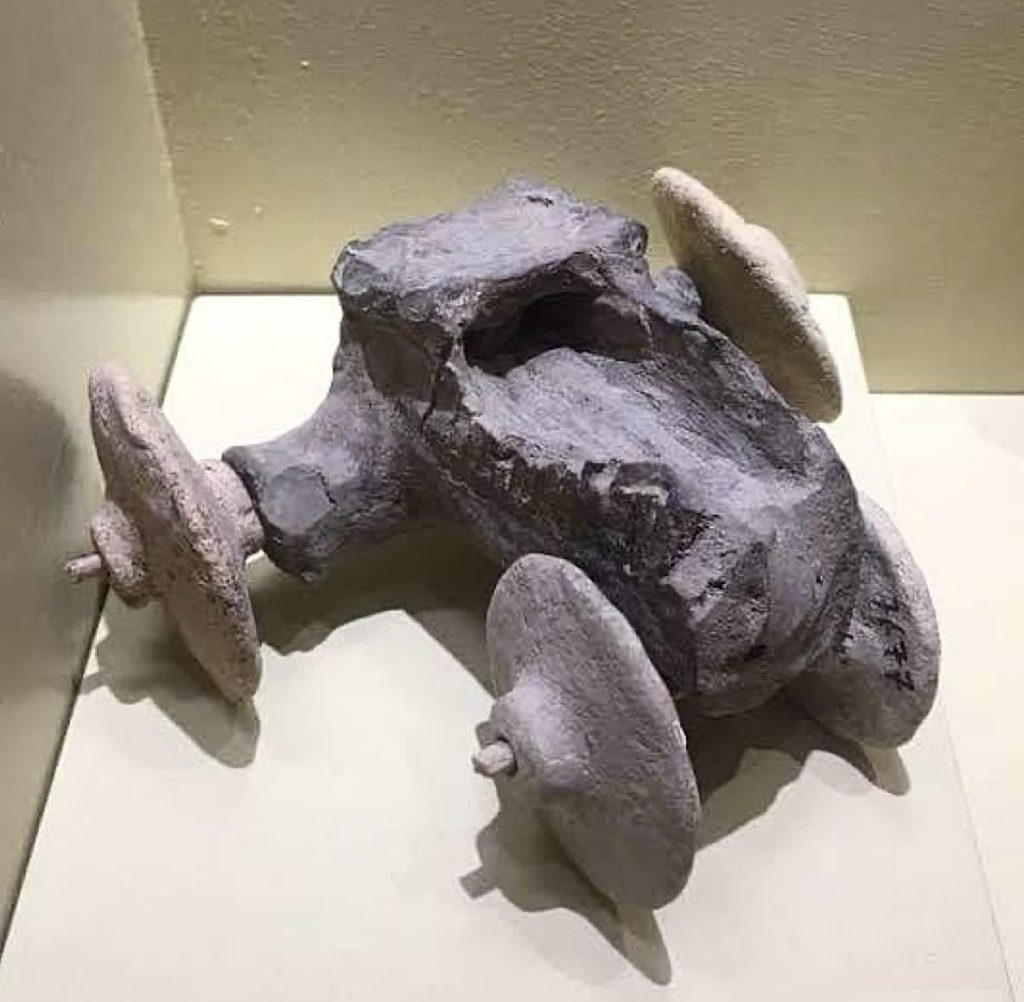In a remarkable turn of events in the world of archaeology, researchers in Turkey have unearthed what could very well be the oldest toy car ever discovered. This find doesn’t just charm historians and enthusiasts—it opens a new chapter in our understanding of early childhood, craftsmanship, and cultural life during the Bronze Age. Dating back an astonishing 5,000 years, the small, wheeled object was found buried in a child’s tomb within the ancient city of Sogmatar, located in the southeastern region of Turkey. While today’s children may dream of Hot Wheels or remote-controlled cars, this ancient toy reveals that the desire to play, explore, and mimic adult behaviors has been part of human culture for thousands of years.

Sogmatar is a site steeped in legend and layered in time, believed by many scholars to have been a sanctuary associated with the biblical figure Moses. Once a spiritual and cultural hub during the Bronze Age, it has remained mostly untouched for centuries. Recent excavations, however, led by archeologist Celal Uludag and his team, have begun to peel back the layers of time to reveal a treasure trove of ancient artifacts. Among the most emotionally resonant of these discoveries is the small, earthenware chariot complete with wheels—likely a plaything that once belonged to a child from a noble or royal lineage. This artifact is not only a piece of historical evidence; it’s a direct, almost poignant, link to the intimate daily life of an ancient child.
When unearthed from the child’s tomb, the miniature chariot was largely intact, its simple yet purposeful construction highlighting the creativity and craftsmanship of Bronze Age artisans. Constructed from clay, it was fashioned with care, likely painted at some point, and designed to roll—perhaps across the floor of a stone dwelling or a dusty courtyard. Such a toy would have held deep value, both emotionally and culturally, within the context of the family it belonged to. It may have been more than a child’s distraction—it could have symbolized status, future aspirations, or even spiritual significance within the burial ritual. The inclusion of this toy in a child’s tomb suggests that just as in modern times, ancient people valued the joy and comfort that play brought to their youngest members.
The broader excavation at Sogmatar has yielded no shortage of important finds. To date, archaeologists have uncovered 45 tombs, many of which date back to Roman times. However, three of these tombs had remained completely untouched for nearly two millennia, providing an unspoiled glimpse into the past. These burial sites have offered new perspectives on how people lived, honored their dead, and what they considered significant in both life and the afterlife. Among these revelations, the toy chariot stands out—not just for its uniqueness, but for what it represents: a timeless human desire to simulate real life through play, and a deep-rooted cultural investment in children’s happiness and development.
Lead archaeologist Celal Uludag expressed the importance of this discovery in terms that reflect both scholarly insight and heartfelt appreciation. “This finding is very important for us as it shows the aesthetic and cultural understanding of the period,” he stated. Indeed, the object offers tangible proof of the values, artistic abilities, and social structures of the time. It reveals that the concept of childhood, far from being a modern invention, was recognized and cherished even thousands of years ago.
As with many significant archaeological finds, the toy chariot will not be kept hidden away in storage. Plans are already in motion to display it in the Sanliurfa Archaeology Museum, the largest museum complex in Turkey. There, it will be preserved and presented alongside other artifacts from the region, helping to paint a fuller picture of life in the ancient world. Visitors will not only marvel at its age and condition but also gain insight into the sophisticated societal norms of the people who made and used such objects.
This exhibit promises to be more than just a showcase of an ancient toy. It’s an invitation to reflect on how much—yet how little—has changed in human nature over the millennia. Children continue to play with cars and trucks, dream of motion and speed, and enjoy simple pleasures that transcend technological development. Meanwhile, parents and societies continue to provide these forms of joy, embedding love and care into even the smallest tokens of childhood.
The implications of this find stretch far beyond its immediate context. It challenges long-held assumptions about the history of toys, suggesting that the desire for movable, miniature objects has been present for much longer than previously believed. It also expands our understanding of early technological ingenuity, as the ability to craft wheeled objects on a small scale would have required a keen understanding of both materials and motion. These insights add new depth to our understanding of ancient civilizations, helping us recognize that they were not so different from us after all.
Archaeology often reveals grand temples, intricate mosaics, or storied tombs, but sometimes the most profound connections to our ancestors come through the simplest objects. This 5,000-year-old toy car may lack the grandeur of a monument, but it carries the emotional weight of history in a uniquely powerful way. It invites us to see the past not just as a series of dates and events, but as a lived experience filled with emotion, imagination, and care.
As excavations continue in Sogmatar, archaeologists are hopeful that even more discoveries await—finds that will not only enhance our historical knowledge but also deepen our emotional connection to those who came before us. The small, humble chariot buried with a child speaks louder than words: joy, creativity, and the impulse to play are eternal parts of the human spirit.





